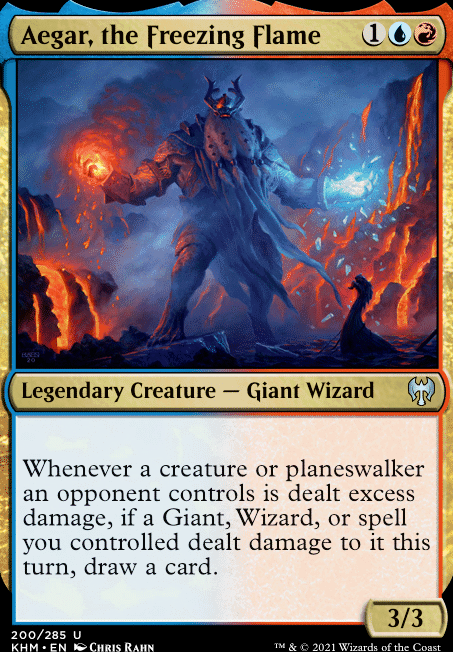Dualcaster Mage + Twinflame produces as many copies of Dualcaster Mage as you like, each with haste. You must cast Twinflame first, hold priority, and only then cast Dualcaster Mage. When the Mage resolves, use its ETB to copy the Twinflame that's still on the stack. That copy makes another Dualcaster Mage, which copies Twinflame again...you get the idea. You can stop the combo because Twinflame lets you choose "any number" of creatures you control and 0 is a valid choice.
However, you must target a creature you control with Twinflame. This is a significant downside in a deck with few creatures and you might wonder why I'm not playing Heat Shimmer instead of, or in addition to, Twinflame. Since that's really two separate questions, I'll give two separate answers.
Q: Why not play Heat Shimmer instead of Twinflame?
A: Three reasons.
- It's more expensive
- It's slightly harder to tutor
- The ability to use Heat Shimmer on an opponent's creature as a non-combo line is minimally useful in a deck that doesn't do any real combat damage until the late game.
The fact that Heat Shimmer is only one mana more expensive than Twinflame may seem insignificant. It's a 5 mana combo vs a 6 mana combo. But this is also a 35 land deck. You'll sometimes need to go for the combo with counterspell backup, so saving a single mana may be quite significant. If you have this combo in your opener, it's nice to have the option to combo early. And you may not hit 6 straight land drops or 5 + a mana rock with a combo heavy opener. Some slots that might otherwise be card draw will be taken up by the combo pieces.
Spellseeker and Muddle the Mixture both find Twinflame but not Heat Shimmer. This also relates to point #1 above: if you have to tutor for Twinflame the same turn you combo, you want it to be cheaper.
Heat Shimmer does have utility when used on opposing creatures, especially since there are several ways to recur spells in this deck. You might get a sweet ETB trigger or a big attack with a copied fatty. The ETB trigger part is entirely up to your playgroup/meta, but generally I don't want to play a card because my opponent might have a creature with a useful ETB for me. The part where you can maybe copy a big creature and attack with it once doesn't matter if your plan A is to win with infinite damage.
Q: Why not play Heat Shimmer in addition to Twinflame?
A: Two reasons:
- Both are bad cards individually
- Adding Heat Shimmer is not the kind of redundancy that this deck is most interested in
Both Heat Shimmer and Twinflame are cards that you don't cast "for value". They are win conditions first and foremost and you only fire one off in other circumstances if you need to do it to survive. Dualcaster Mage, on the other hand, is a good card. It does lots of useful things for a good rate, and does them at instant speed. If there was a second card like Dualcaster Mage I would play that. Then and only then would I consider adding Heat Shimmer, since I would be more likely to find a Dualcaster Mage effect I'd want to also increase my odds of finding an effect that can copy him.
As for redundancy, it's definitely good, especially in combo decks. However in EDH the concept is widely misunderstood. You don't need 8 copies of an effect if you want to reliably find it. You need one copy that you can reliably find. Sometimes you don't even need card redundancy. What's more valuable in many cases is strategic redundancy--a seamless trainsition into a reliable Plan B in the event Plan A falls apart. This deck achieves card redundancy through a mix of tutors and card velocity. It achieves strategic redundancy through independent combos that benefit from the same supporting card clusters and several non-combo win conditions if both combos aren't viable.
So, with that explanation out of the way, the downside of Twinflame compared to Heat Shimmer still has to be respected. Sometimes your creatures will die and you'll have to cast a 5 mana Aegar and hope to survive until next turn to combo. But if you include the token-making potential of this deck, you should be able to stick a single creature for this combo most of the time.


